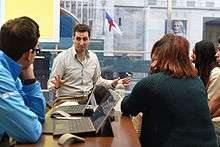Harkness table


The Harkness table, Harkness method, or Harkness discussion is a teaching and learning method involving students seated in a large, oval configuration to discuss ideas in an encouraging, open-minded environment with only occasional or minimal teacher intervention. The method is in use at many American boarding schools and colleges and encourages classes to be held in a discursive manner. The style is related to the Socratic method. Developed at Phillips Exeter Academy,[1] the method's name comes from the oil magnate and philanthropist Edward Harkness, a graduate of St. Paul's School, who presented the school with a monetary gift in 1930. It has been adopted in numerous schools, where small class-size makes it effective, but it remains impractical for larger classes. Harkness described its use as follows:
- What I have in mind is [a classroom] where [students] could sit around a table with a teacher who would talk with them and instruct them by a sort of tutorial or conference method, where [each student] would feel encouraged to speak up. This would be a real revolution in methods.[2]
Harkness learning can vary, most notably between humanities subjects such as English and history and technical subjects such as math or physics. There are general principles and goals, however, that go along with that method regardless of subject matter. The main goal is to encourage students to come up with ideas of their own, learn good reasoning and discussion skills. Depending on style, the teacher may interact very little, interjecting only to guide the discussion.
See also
References
- ↑ "The Amazing Harkness Philosophy". Phillips Exeter Academy. Retrieved 2011-06-25.
- ↑ Christophe G. Courchesne, "'A Suggestion of a Fundamental Nature': Imagining a Legal Education of Solely Electives Taught as Discussions", Rutgers Law Record 29, no. 21 (2005): 26.
External links
- 'Edward S. Harkness, 1874-1940', Richard F. Niebling, Phillips Exeter Academy (PDF)
